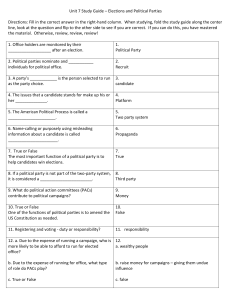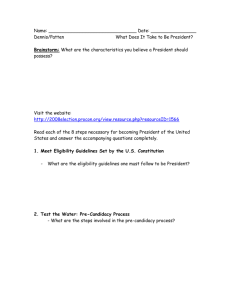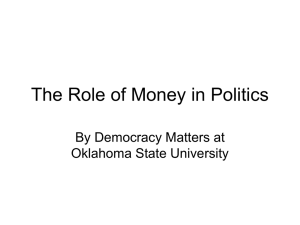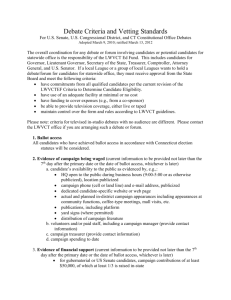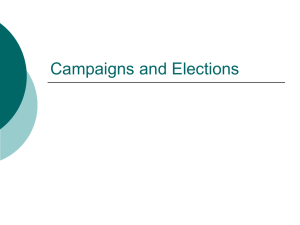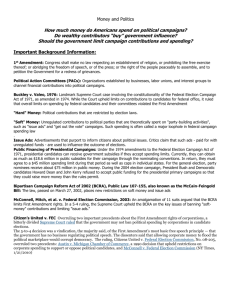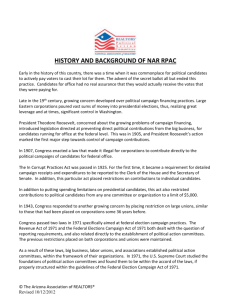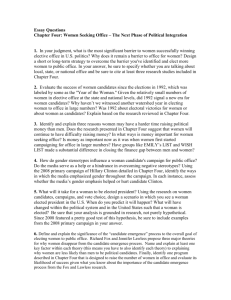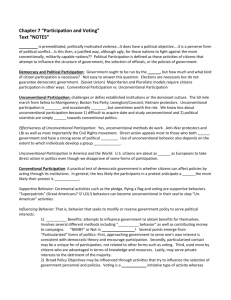Political Parties Three Part Political Party Model (Formulized By V.O.
advertisement
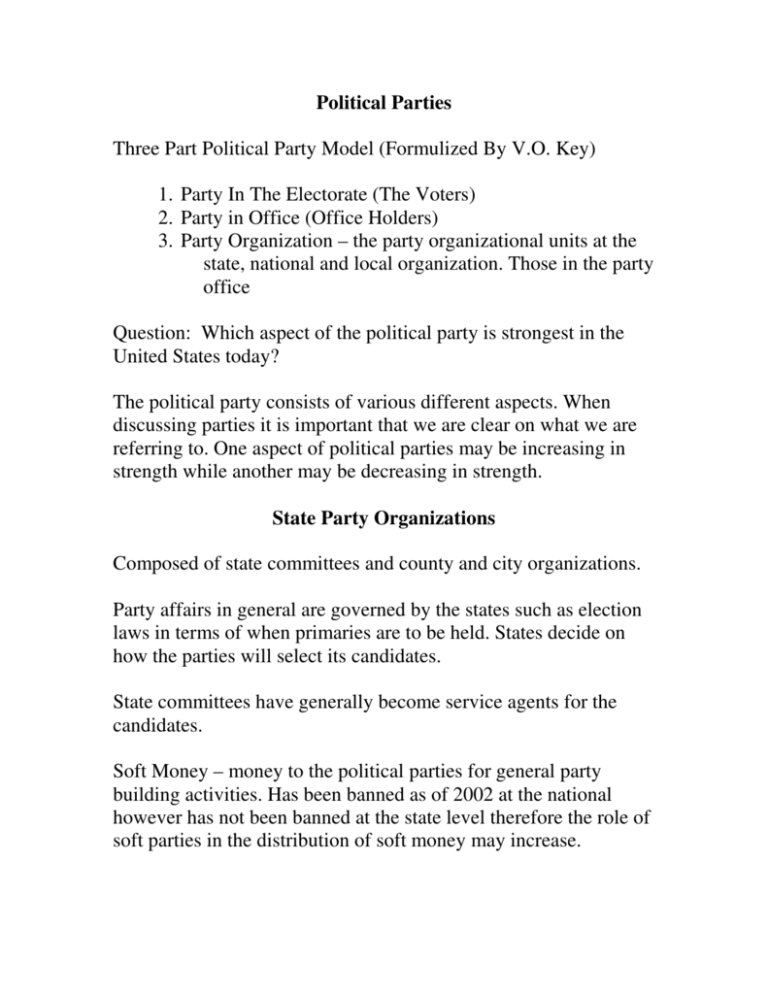
Political Parties Three Part Political Party Model (Formulized By V.O. Key) 1. Party In The Electorate (The Voters) 2. Party in Office (Office Holders) 3. Party Organization – the party organizational units at the state, national and local organization. Those in the party office Question: Which aspect of the political party is strongest in the United States today? The political party consists of various different aspects. When discussing parties it is important that we are clear on what we are referring to. One aspect of political parties may be increasing in strength while another may be decreasing in strength. State Party Organizations Composed of state committees and county and city organizations. Party affairs in general are governed by the states such as election laws in terms of when primaries are to be held. States decide on how the parties will select its candidates. State committees have generally become service agents for the candidates. Soft Money – money to the political parties for general party building activities. Has been banned as of 2002 at the national however has not been banned at the state level therefore the role of soft parties in the distribution of soft money may increase. State party chairs play different roles depending on the state. Some are more powerful than others that are more of a political agent. County Party organizations – building blocks for other layers of the party. Local Party Organizations – often are temporary and just engage in election year activities. 1. Activists as ideologues 2. Activist as potential candidates Are political parties becoming weaker? Various factors have been indicated as being possible factors in the weakening of political parties in the United States. 1. Primary Elections – parties can no longer control who the nominee for their party is. 2. Decline of party identification – loyalties to each of the two parties has been declining in recent years. 3. Candidate-centered politics – candidates run their own campaigns and have their own campaign funds this weakening loyalties 4. Influence of the mass media – campaigns are now media driven by television and party workers are no longer necessary to carry a candidates message from door to door. 5. Decline of patronage – rewards for electoral victory has been diminished by the decline of patronage. 6. Rise of single-issue interest groups and PACs –mist money goes directly to the candidates and not to the party. What functions do political parties play? 1. Organize elections and narrow choices for voters 2. Party labels have a strong impact on voter choice. 3. State party organizations play an important role in shaping the party’s image with the voters. 4. Democrats and Republican play the central task of organizing state legislatures. Political Campaigns Candidate-centered politics – candidates have most of the initiative and influence Party-centered politics – parties hold most of influence and initiative in campaigns Recent Trends in Election Fortunes of the Two Parties Democrats in general do a better job in getting people to register to vote. In areas dominated by a certain party individuals tend to register with that party die to patronage positions. Republicans are making greater gains into state houses and governorships. Is party competition increasing in the states? Party composition is uneven in the states with growing party strength in the south. How does party competition in the state affect public policy? Little evidence exists as to the linkage between party competition and spending in the states. Party competition impact n public policy is likely to be impacted by public preference on an issue and weather it is unimodal or bimodal The Nomination Process Process to decide who will run for office as a party’s candidate 1. Direct Primary – voters choose candidate A. Open Primaries (any voter can vote) B. Closed Primaries (only members of the party can vote) 2. Party Organization – party leadership decides on candidates Question: How has the direct primary affected the influence of the party? Filing for candidacy is controlled by the states and anyone can file for candidacy. Can be placed on the ballot without the permission of the party. Primaries reduce the usefulness of endorsements. State party conventions rarely have an impact on the primaries. Political Campaigns 1. Marketing candidates with the use of public opinion polling computerized mailing lists, developing media events and so forth. 2. Public Relations Firms 3. Polling 4. Name Recognition 5. Campaign Themes 6. Personality not policy is important 7. Grass Roots campaigning 8. Media Campaigning 9. Negative Ads 10. Free Air time such as debates Campaign Financing Hard Money – given directly to candidates $1000 Individual Limit *Increased in 2002 to $2000 $ 5000 PAC Limit Soft Money – given to the parties instead of the candidates and are not subjected to legal limits Question: Do we need campaign finance reform and if so what reforms are necessary? Courts have held that you can spend all you want of your own money. If contribution limit is too low it can interfere with the ability of an individual to participate in politics. Question: What is the impact of campaign contribution limits? Question: Should we have public financing of campaigns? Importance of Money in State Politics Varies by state (California most expensive in general. More important in contested states Early money is important More important in larger jurisdictions in which greater media use is needed Law of diminishing returns on spending Incumbents more successful in raising money Incumbency advantages are greater than heavy spending Candidate spending most money usually wins. Need for greater fundraising. More reliance on PAC for money and cost of campaigns increase Campaign Finance Reform Laws vary state by state. 1. 2. 3. 4. Some laws limit campaign contributions and spending Require financial disclosure Establish public funding Establish oversight agencies. Most campaign finance law was written in the aftermath of Watergate. 2002 Campaign Finance Reform Prohibit soft money Campaign contributions from individuals raised to $2000 Campaign ads from interest groups corporations and interest groups can not be ran 60 days before a general election or 30 days before a primary election. Independent expenditures must be reported to Federal Elections Commission Quality Challenger Characteristics Candidates need a lot of money to be successful candidates for office and they need the money early on in the campaigns. It is difficult to overcome the advantages of an entrenched incumbent. Factors In Determining Challenger Quality 1. Ability to raise a lot of money early 2. Name Recognition 3. Electoral Conditions (Incumbent scandal, economic downturns make it easier for the challenger)
